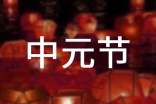- 相关推荐
中元节的由来英文版
中元节,俗称鬼节、施孤、七月半,佛教称为盂兰盆节。与除夕、清明节、重阳节三节是中国传统的祭祖大节,也是流行于汉字文化圈诸国的传统文化节日。下面就是小编整理的中元节的由来英文版,一起来看一下吧。

中元节的由来英文版:
The name "Yuan Zhong" originated in the Northern Wei Dynasty and was a Taoist statement. According to ancient records: one to the first fifteen is the "spring", as the day official blessing on July; fifteen is the "middle", as officials on fifteen October is "forgiveness; Yuan", as the official water solution on. According to the "practice" records: "in July motohi officer down, set the world of good and evil, then the night of Taoist chanting, also free day hungry prisoner." Therefore, in July 15th this day, all have rich folk religious worship to officials and ancestors.
The ghost festival is a product of Taoism and traditional folk China combination, the two to the corresponding, is mainly based on the same universe view: Heaven and earth, water three, deified for three days, the government department officer officer, officer under the water. Folk known as "three public", is the three official refers to the three gods.
Chinese Eastern Han Dynasty, Taoism has integrated Taoist View of the universe before the stage, need to first pass on the "three official calligraphy", were cast in the heavens and the earth, the water, said the three officer to repent of sins, to pray for peace. Through the development of the Six Dynasties period, three day and three yuan in the Tang Dynasty advocated the thought of combination, the official, Shangyuan, yuan to three yuan, down motohi stereotypes, worship worship, Najib blessing become three Yuan emperor Festival, Festival ceremony participation rate of officials. Tang and Song Dynasty, became the three motohi folk festival.
The ghost festival, Taoist temples, such as the Dianmen fire temple, the West will be outside the White Cloud Temple to pray for "good and peaceful" year "auspicious blessing Temple held as usual". Because of the psychological fear of Li, the people in the daily life of composite of Confucianism, Buddhism and Taoism, the the 15th day of the seventh month of the Chinese lunar calendar ghost festival called Halloween, known as the lunar July "ghost month".
The introduction of Buddhism, Buddhism is also a kind of their forefathers the religious rituals, known as "Wu Lanma Na" (India ULLAMBANA), namely "Obon will". Obon is the meaning of life is like the pain hung upside down, upside down in the tree on the head of the bat, hanging, miserable. In order to make people from a difficult situation, we need food for the vast cloth chanting, wandering souls. This is the month China ghost worship and Buddhism in the 15th day of the seventh month of the Chinese lunar calendar also agree without prior without previous consultation, the day held salvation method, which will also Ghost Festival and Meng LAN handed down.
翻译:
“中元”之名起于北魏,是道教的说法。根据古书记载:道经以正月十五是“上元”,为天官赐福日;七月十五是“中元”,为地官赦罪日;十月十五是“下元”,为水官解厄日。据《修行记》记载:“七月中元日,地官降下,定人间善恶,道士于是夜诵经,饿节囚徒亦得解脱。”因此,在七月十五日这一天,民间都会准备丰富的牲礼,祭拜地官大帝及祖先。
中元节是道教与中国传统民俗相结合的产物,二者能够相应,主要是基于同一宇宙观:即天、地、水三界,被神格化为天官、地官、水官所统辖的三界府署。民间通称的“三界公”,便是以三官泛指三界众神。
中国东汉末年,天师道便已综合前道教期的宇宙观,首过需上“三官手书”,分别投于天、地、水中,表示向三官忏悔罪过,以祈求平安。经历六朝时期的发展后,三会日与三元思想结合,在唐代官方的提倡下,上元、中元、下元等三元日定型化,成为祈福纳吉、祭祖拜神的三元节日,皇帝率百官参与节日仪式。唐、宋以后,三元日成为民俗节日。
中元节时,道教宫观,如地安门火神庙、西便门外白云观等为了祈祷“风调雨顺、国泰民安”每年照例举办“祈福吉祥道场”。因为惧厉的心理,民众于日常生活中复合儒、佛、道三教,将农历七月十五的中元节称为鬼节,称农历7月为“鬼月”。
佛教传入后,佛教中也有一种追荐祖先的超度仪式,称为“屋兰玛纳”(印度话ULLAMBANA),也就是“孟兰盆会”。孟兰盆的.意义是倒悬,人生的痛苦有如倒挂在树头上的蝙蝠,悬挂著、苦不堪言。为了使众生免於倒悬之苦,便需要诵经,布绝食物给孤魂野鬼。此举正好和中国的鬼月祭拜不谋而合,且佛教也是在农历七月十五这一天举行超度法会,因而中元节和孟兰会便同时流传下来。
[中元节的由来英文版]
【中元节的由来英文版】相关文章:
中元节鬼节的由来09-04
中元节的由来与传说09-01
中元节的由来及习俗介绍10-30
中元节的由来是什么09-23
中元节的由来作文07-01
关于中元节的由来及习俗详解11-17
元旦的由来英文版10-05
国庆节的由来英文版10-10
清明节的由来英文版09-08
有关中元节的由来和习俗09-16